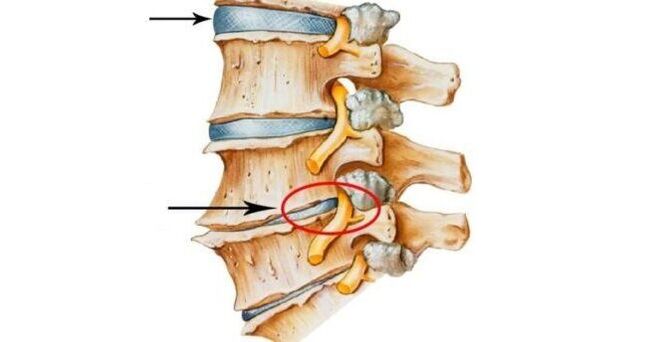Osteochondrosis of the cervical spine causes rapid aging of the intervertebral discs and vertebral bodies of the neck. Dizziness and headache are the main symptoms. Often the changes develop in the most mobile parts of the spine.

Reasons
The fact that osteochondrosis develops only in old age is a delusion. In recent years, signs of cervical osteochondrosis have been found in young people aged 16-20. The appearance of the disease occurs for the following reasons:
- Disorders of metabolic processes.
- Tobacco and alcohol abuse.
- Low physical activity (hypodynamics).
- Injuries.
- Long sitting position.
- Excess weight.
- Sleep disorders.
- genetic predisposition.
Symptoms of cervical osteochondrosis are often confused with cold or banal fatigue. If signs of illness appear, you should see a doctor as soon as possible.
Symptoms
Symptoms include spinal cord injury and narrowing of the arteries and veins that run through the body of the vertebrae. Cervical sciatica (radicular syndrome) manifests itself with numbness in the shoulder blades, shoulders, arms, as well as pain and tingling. Anxiety may be felt in the neck and chest (front).
The first signs of osteochondrosis of the cervical vertebra:
- slight pain in the neck;
- crunchy when turning the head;
- periodic pain in the head and neck, heaviness in the back of the head, numbness in the arms and shoulders.
Dizziness is a symptom of cervical osteochondrosis that appears after waking up at night or in the morning. A few turns of the patient's head are enough to see the dizziness.
Accompanied by the manifestation of dizziness:
- loss of orientation in space;
- the feeling of "shaking the floor" under the foot;
- balance loss;
- noise and ringing in the ears;
- nausea and vomiting;
- redness or pallor of the face;
- headache and increased sweating.
An attack of dizziness causes blurred vision, increased heart rate, numbness of the hands, the appearance of "flies" in front of the eyes.
Preventive measures for dizziness are proper nutrition (with sufficient amounts of vitamins B and C) and proper sleep organization (low pillows, hard mattresses). Drug treatment for dizziness is aimed at normalizing blood circulation to the brain.
Exacerbation of the disease
Symptoms of exacerbation of osteochondrosis of the cervical spine may include:
- Pain in the occipital region and neck passes to the arms, shoulder blades and shoulders.
- Increased pain during head movements, sneezing, coughing.
- Mandatory position of the head (to relieve pain).
- The pain can be localized in different places, which prevents the diagnosis.
- Prolonged headache and dizziness.
- Violation of vision, hearing, coordination of movements.
- Increased muscle tone in the extremities and neck against the background of general weakness.
- Decreased skin sensitivity (numbness, dryness, tingling, cold).
- Sleep disorders, memory disorders, increased anxiety.
Diagnostic methods are used to check the condition of the neck vessels - duplex scanning or ultrasound dopplerography.
Complications
Symptoms that are not detected and treated in time can lead to the following complications:
- Protrusion (protrusion) between the vertebrae of the cervical spine.
- Cervical hernia (intervertebral).
- Radiculopathy (damage to one or more nerve roots).
- Formation of large osteophytes of the cervical spine.
- Parez (incomplete paralysis).
- Compression of the blood vessels that feed the brain.
- Dupuytren's contracture. Pathologically, the palm is deformed, the fingers are squeezed, and the hand stops functioning normally.
Osteochondrosis and VVD
The symptoms of VVD (vegetovascular dystonia) in cervical osteochondrosis are interrelated. These pathologies are links in the same chain that require increasing attention, diagnosis and treatment. Often, vegetovascular dystonia is the result of cervical osteochondrosis.
Dystonia is accompanied by the following symptoms:
- Vertigo.
- Heartbeat and pain in the heart area.
- Respiratory disorders (increased respiration, shortness of breath).
- Lowering blood pressure.
- Disorders of internal organs (stomach, intestines, urinary organs).
- Changes in body temperature during the day (between 35 and 38 degrees).
- Irritation, tears, anxiety.
The reason for the development of vegetative-vascular dystonia may be hormonal failure, endocrine disorders, overweight, genetic predisposition. The main symptoms of VVD in cervical chondrosis: muscle fatigue, loss of body control.
The presence of these symptoms requires a correct diagnosis, and this is possible only after a thorough examination. Self-treatment of the disease is unacceptable!
Diagnostics
The examination begins with an examination and analysis of all the patient's complaints. Diagnosis allows to exclude diseases of the heart and blood vessels, stomach and intestines. Diagnostic measures include:
- Radiography.
- CT (computed tomography).
- MRI (magnetic resonance imaging).
- Myelography.
A neurological examination is performed to determine the degree of sensory and motor disorders.
Treatment of the disease
Therapeutic measures are aimed at eliminating inflammation and relieving pain in the affected area. Drug treatment regimens are represented by the following groups of drugs:
- NSAIDs (non-steroidal anti-inflammatory drugs).
- Chondroprotectors - drugs that allow you to stop the destruction of cartilage and help restore cartilage tissue.
Ointment treatment is very common, but ineffective. Self-medication patients use ointments containing irritants or ointments of the NSAID group. The drug in the ointment will not be able to penetrate the damaged area through the dense layer of skin and muscles.
An important benefit of ointments in neck massage while rubbing the drug.
Symptoms of cervical osteochondrosis are treated with B vitamins. Combined preparations for intramuscular application have proven to be good. The solution contains B vitamins: cyanocobalamin (B12), pyridoxine (B6), thiamine (B1).
Complex treatment includes: physiotherapy, acupuncture, hirudotherapy (treatment of leprosy), massage, exercise therapy (physical therapy), manual therapy.
The complex of exercise therapy for the neck is presented in this video. Daily performance of these exercises will help to get rid of unpleasant symptoms.
Disease prevention
To prevent the development of cervical osteochondrosis, it is recommended to warm up periodically during work, avoid stress on the neck, avoid sudden head movements, control posture, avoid hypothermia, exercise and eat properly.



















